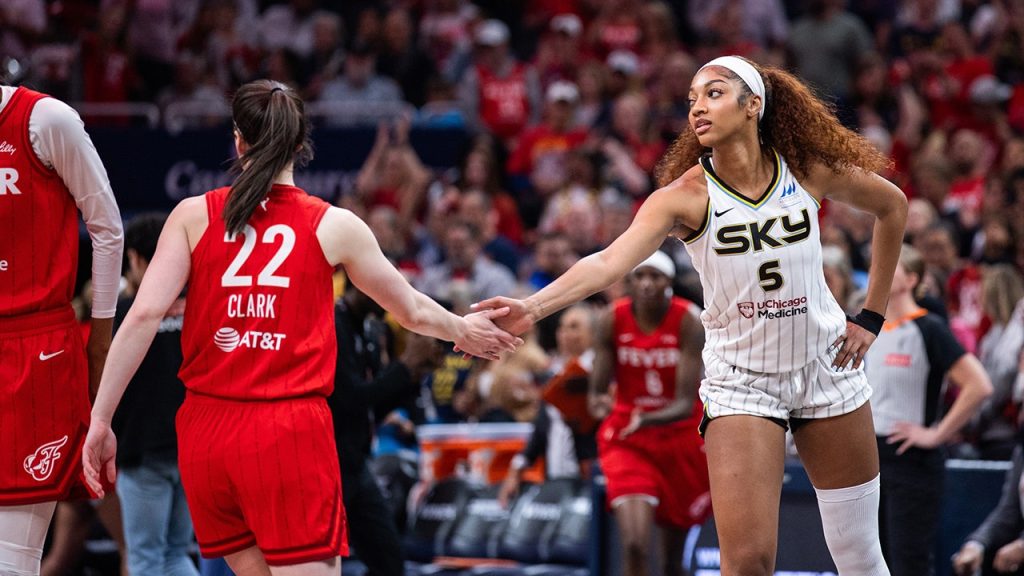In a highly charged matchup on May 17, 2025, at Gainbridge Fieldhouse, the rivalry between Indiana Fever’s Caitlin Clark and Chicago Sky’s Angel Reese flared up during the third quarter. Tensions escalated when Clark fouled Reese, leading to a sequence of events that involved player confrontations and referee interventions. This incident adds yet another layer to their intense history, underlining the fierce competitive nature of the WNBA.
| Article Subheadings |
|---|
| 1) Tensions Rise: Clark and Reese’s On-Court Exchange |
| 2) The Context of Their Rivalry |
| 3) Referee’s Decision Sparks Debate |
| 4) Public Reactions and Media Coverage |
| 5) The Future of the Rivalry |
Tensions Rise: Clark and Reese’s On-Court Exchange
The heated exchange between Caitlin Clark and Angel Reese occurred during the third quarter as Reese fought for a rebound off a missed shot from her teammate Rebecca Allen. The play escalated when Caitlin Clark fouled Reese as she attempted to shoot, prompting Reese to fall to the court. After getting back on her feet, Reese confronted Clark, igniting tensions on the court that caught the attention of players, coaches, and spectators alike. Such confrontations are a hallmark of competitive sports, and this incident was no exception, bringing the competitive spirits of both players to the forefront.
The Context of Their Rivalry
The rivalry between Clark and Reese dates back to their college careers, where they frequently faced off in highly-trafficked matchups that captivated basketball fans. Their competitive interaction was fueled in part by their contrasting playing styles and strategies that often put them at odds on the floor. Prior to this game, they had been vocal about the significance of rivalries in sports, indicating that such matchups elevate performance levels and keep fans engaged. Clark’s remarks on the intensity of rivalries indicate her belief that these moments define careers and add a unique flair to the sport.
Referee’s Decision Sparks Debate
In a critical moment post-foul, referees reviewed the incident and determined that Clark had pushed Reese to the ground with sufficient force to warrant more than just a standard personal foul. As a result, they upgraded the foul to a flagrant foul, indicating that it was more than an inadvertent play. This decision drew mixed reactions from fans and sports analysts alike; some believed it underscored the need for player safety in competitive sports, while others argued that such calls can sometimes inhibit the flow and physicality that are integral to basketball. Furthermore, both Reese and her teammate Aliyah Boston received technical fouls for their subsequent reactions, further intensifying the atmosphere of the game.
Public Reactions and Media Coverage
Media coverage of the incident was swift, with various outlets highlighting the drama that unfolded on the court. Fans took to social media to weigh in on the exchange, creating a mixed landscape of support and criticism for both players. Some viewed Clark’s foul and the ensuing confrontation as part of the fierce nature of sports rivalries, while others lamented the growing animosity on the court. The coverage of the incident was bolstered by previous encounters between the teams, which had garnered significant viewership and added pressure to the game. Observers noted that clashes between such high-profile players often serve as a catalyst for increased media attention, with fans eagerly awaiting the next chapter in this ongoing rivalry.
The Future of the Rivalry
With the Sky and Fever teams scheduled to meet several times throughout the 2025 season, the rivalry between Caitlin Clark and Angel Reese is expected to intensify. As players grow more accustomed to facing each other, as well as the stakes associated with these matchups, fans can anticipate further showcases of competitive spirit and athletic prowess. The anticipation surrounding these upcoming games is considerable, as both players represent the best of women’s basketball, and their history suggests that future encounters will be no less dramatic. This rivalry not only has implications for the players themselves but also for the teams, their respective fanbases, and the overall narrative arc of the WNBA.
| No. | Key Points |
|---|---|
| 1 | The altercation between Clark and Reese highlights the fierce competitive nature present in women’s professional basketball. |
| 2 | The rivalry between the two players has a storied history rooted in their college careers, contributing to the narrative of their professional engagements. |
| 3 | Referee decisions regarding the foul escalated the tension, reflecting ongoing debate around player safety in competitive sports. |
| 4 | Media and fan reactions indicate the significant public interest surrounding their rivalry, impacting both players’ careers. |
| 5 | Future matchups promise to heighten already charged emotions between the Sky and Fever teams. |
Summary
The confrontation between Caitlin Clark and Angel Reese during their recent game serves as a microcosm of the fierce rivalries that define women’s professional basketball. As the WNBA season progresses, the narrative surrounding their competitive dynamic will likely continue to develop, capturing the attention of fans and analysts alike. The incident not only adds drama to their individual stories but also highlights the broader complexities of athletic competition, including the relationships, tensions, and rivalries that come to define a sport.
Frequently Asked Questions
Question: What led to the confrontation between Caitlin Clark and Angel Reese?
The confrontation was sparked when Clark fouled Reese as she attempted to shoot after grabbing an offensive rebound, which resulted in Reese confronting Clark on the court.
Question: What was the referee’s decision regarding the foul?
The referees deemed Clark’s foul serious enough to be upgraded to a flagrant foul, indicating the push had enough force to warrant a more severe penalty.
Question: How have fans and media responded to the rivalry between Clark and Reese?
Fans and media have had mixed reactions, with some praising the intensity of their rivalry as part of the sport’s appeal, while others have raised concerns over the animosity displayed on the court.


